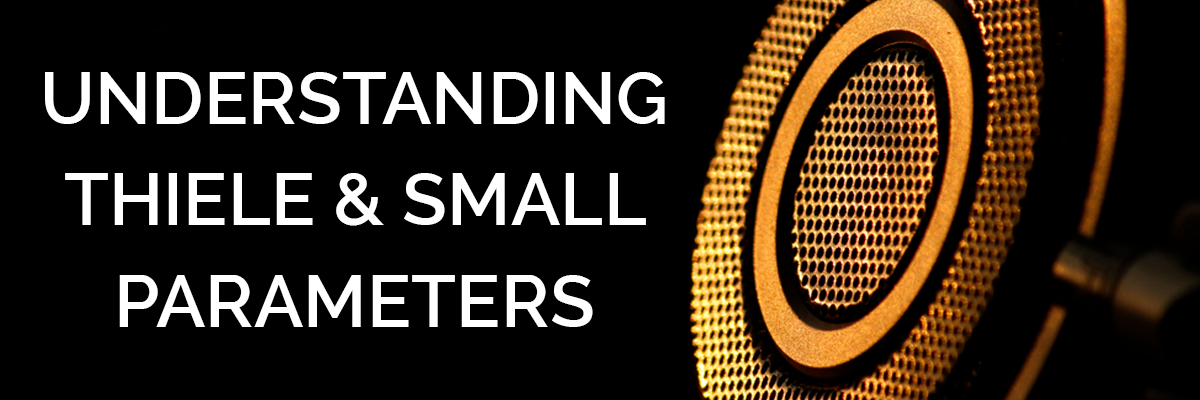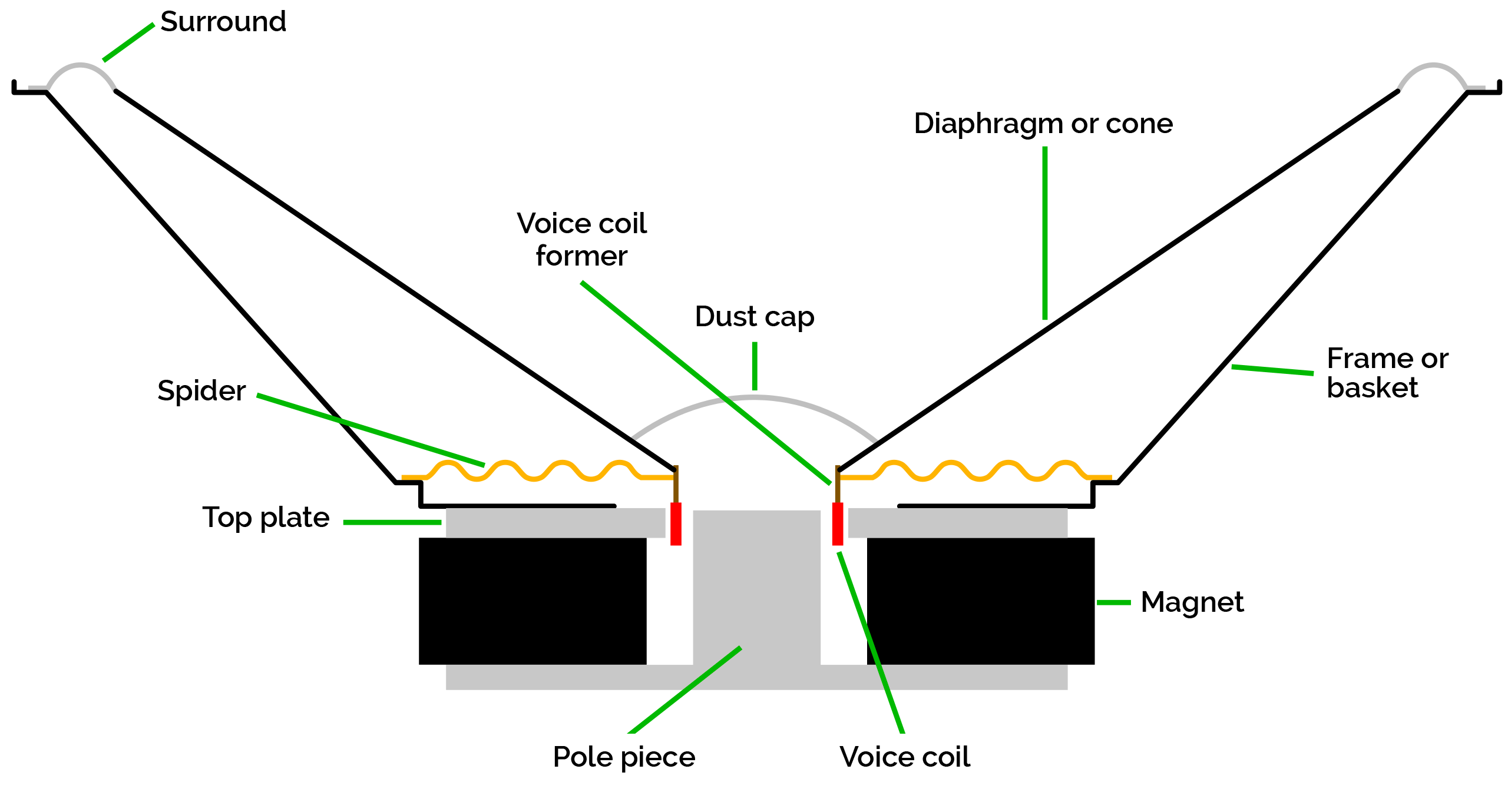New Customer?
Create your accountNo products
Prices are tax included
[GUIDE] Discovering Speakers: Understanding the Thiele and Small Parameters

1. Introduction
When designing a speaker, or even in the case of a faulty speaker driver replacement, it can be difficult to select the right model(s). One often finds oneself drowned in a large mass of characteristics, as vague as they are essential. Indeed, it is these electromagnetic specifications that define the behavior and performance of a loudspeaker. These data are the Thiele and Small parameters
2. Historical overview
It is the technical documents published by the AES (Audio Engineering Society) that allowed the development of the Thiele and Small parameters, characterizing a specific loudspeaker. In the early 1970s, two Australian scientists - A. Neville Thiele, then Chief Engineer in the Concept and Development Department of the Australian Broadcasting Commission and head of the Federal Engineering Laboratory, and Richard H. Small, a research fellow at the School of Electrical Engineering at the University of Sydney - worked to define the relationship between a loudspeaker and a specific speaker. They are modeling the characteristics of loudspeakers by developing a set of parameters related to their characteristics. These parameters are the Thiele and Small parameters, named after their inventors. These are particularly valuable since they provide us with detailed information on the behavior and actual performance of a loudspeaker.
Today, all books and publications dealing with loudspeakers and speakers use these parameters. Similarly, all speaker manufacturers provide these values for each model. These values allow, of course, to compare loudspeakers with each other, but above all to select a suitable model for an efficient integration.
3. Composition of a loudspeaker
The following diagram details the different components of a loudspeaker, as well as their functions. The associated explanations will allow you to understand the different Thiele and Small parameters.

Surround : The periphery of a loudspeaker is fixed by a more or less flexible border: the surround. This one allows to maintain the diaphragm while leaving it a sufficient liberty of movement. It also prevents the diaphragm from splitting and dampens the induced resonances. Different materials and shapes can be used for the design of a surround.
Spider : Complementary to the surround, the spider participates in the centering of the moving parts, namely the voice coil and the diaphragm. In order to allow movement on a single axis and thus limit non-linear distortions, it is essential to have a support at the level of the voice coil. The distance of the voice coil from the magnet must be constantly the same and these elements must never touch each other. The spider therefore serves as a rear suspension. It is in the form of a disc fixed between the voice coil former and the frame. Most spiders are made of resin-impregnated fabric.
Voice coil former : This element provides the link between the voice coil and the rest of the moving parts, especially the diaphragm and the dust cap.
Diaphragm / Cone : It can be made of a wide variety of materials, such as paper, carbon fiber, aluminum or Kevlar. It is this which moves in order to create a movement of air and thus a sound wave.
Dust cap : This piece has a simple role. To protect the voice coil and the voice coil former, especially from dust and filings. This element does not impact the sound reproduction.
Frame / Basket : The frame is a fixed part that serves as a structure for the entire loudspeaker. Extremely rigid, it can be either deep-drawn or molded.
Top plate : The top plate is a cylindrical pole piece pierced in its center. It allows the fixation of the frame to the magnetic circuit. The modification of the thickness of this element can modify the performance of a loudspeaker.
Pole piece : Placed just below the top plate, this pole piece is cylindrical and generally made of mild steel. It is also a polar piece.
Voice coil : The voice coil receives electrical current from the amplifier. According to the direction of this signal, it acts or not in opposition to the magnetic field exerted on it.
Magnet : The magnet is mostly made of ferrite. It can also be made of Neodymium or Alnico. It can even be an electromagnet.
4. Understanding the Thiele and Small parameters
4.1 Fundamental Parameters
The fundamental parameters correspond to the physical characteristics of a loudspeaker used in equivalent electrical circuit models. They are measured using small signal levels. These values are not obvious and are measured on a finite loudspeaker. It may be more convenient to use the small signal parameters, explained in the next chapter
Sd :
This is the surface of the speaker's diaphragm. It is generally expressed in square centimeter (cm²)
Mms / Mmd :
The moving mass is the sum of the masses of the moving parts: the membrane, the dust cap, the voice coil, the displaced air and the half of the suspension. It is usually expressed in grams (g).
The parameter Mmd is a derivative of Mms, taking into account only the mass of the diaphragm and the voice coil.
Cms :
This value, the suspension compliance, is expressed in meters per newton (m/N). It is a measure of the rigidity of the mechanical suspension of a loudspeaker.
Rms :
This is the >mechanical resistance of the speaker's suspension. It is expressed in newton.seconds per meter (N.s/m) but also in kilograms per second (kg/s).
Le :
This characteristic corresponds to the voice coil inductance in the air gap. It is measured at 1kHz and is expressed in milliHenry (mH).
Re :
The DC resistance of the voice coil. It is expressed in Ohms. This is almost always lower than the nominal impedance of the loudspeaker..
Bl :
This data is a measure of the power of the magnetic motor of the loudspeaker. It is the product of the magnetic field strength in the coil air gap and the length of the coil wire in the magnetic field. This value is expressed in Tm (Tesla.m&egravity) and can be useful for efficiency calculation. A high value is a sign that the loudspeaker is able to move the diaphragm firmly.
4.2 Small signal parameters
These parameters, which are simpler to measure than the fundamental parameters, can be determined by measuring the input impedance of the loudspeaker, close to the resonant frequency, at low input levels where the behavior of the loudspeaker is linear.
Fs :
This is the resonant frequency of the driver in free air. At this frequency, the weight of the moving parts of the loudspeaker, i.e. the diaphragm and coil, balances with the resistance of the suspension and driver assembly. This is an essential parameter to be taken into account in the design of speakers.

Qes :
The loudspeaker's electrical quality factor is measured at its resonant frequency. This corresponds to a measure of the control of the damping relative to the loudspeaker's electric suspension, i.e. the voice coil and the magnet. The mechanical and electrical forces of the loudspeaker oppose each other in order to damp the diaphragm displacement.

Qms :
The mechanical quality factor of the loudspeaker is measured at its resonant frequency. This corresponds to a measure of the control of the damping relative to the mechanical suspension of the loudspeaker, i.e. the suspension and the spider. The mechanical and electrical forces of the loudspeaker oppose each other in order to dampen the diaphragm displacement.

Qts :
The loudspeaker's total quality factor is measured as its resonant frequency. It is the product of the values Qes and Qms. It is generally accepted that a Qts lower than or equal to 0.4 is more suitable for a vented enclosure and a Qts between 0.4 and 0.7 is more suitable for a sealed enclosure.

Vas :
The equivalent compliance volume is the volume of air which, when actuated by the surface piston Sd, is as compliant as the suspension of the loudspeaker. This is a complex value to measure since it is dependent on the air pressure, that it varies according to the rate of humidity and temperature

4.3 Large signal parameters
Xmax :
This value expressed in mm (millimetres) represents the maximum linear peak area of cone excursion. The membrane can indeed move positively and negatively and has a zero point (or state of rest). The value Xmax measures the displacement between the maximum low point and the maximum high point for a linear behavior. If the diaphragm undergoes excursions beyond this value, the loudspeaker will operate in a non-linear manner.
Xmech :
This is the maximum permissible excursion value of the diaphragm, beyond which the loudspeaker could be damaged, including the voice coil and other moving parts. This measure is above Xmax: we are therefore in a non-linear operation..
Pe :
This parameter corresponds to the admissible thermal power of the loudspeaker. It is expressed in W (Watts) and is difficult to define.
Vd :
The value Vd indicates the amount of air displaced during the maximum linear excursion (Xmax). It is measured in cm3 and is the result of the product of Xmax and Sd.
4.4 Other parameters
Zmax :
It is the loudspeaker's impedance at its resonant frequency (Fs). This allows the calculation of the Qms and Qes parameters.

EBP :
A useful parameter to quickly define the most appropriate type of enclosure for a specific loudspeaker. It is the result of dividing Fs by Qes. A value close to 100 will be suitable for a vented enclosure. A value close to 50 will be more suitable for a sealed enclosure. Between these two values, the loudspeaker can be used in sealed and vented enclosure. This measure is used as a "benchmark value" to select a speaker cabinet in the case of the manufacturer would not give specific recommendations.

Znom :
This value is the nominal impedance of the loudspeaker. It is usually 4, 8 or 16 Ohms.
η0 :
This measurement indicates the loudspeaker's efficiency in percent, corresponding to the amount of acoustic energy radiated by the loudspeaker in an undistorted frequency range above the resonant frequency. However, it differs from the SPL value (sound pressure level) because it is not influenced by resonance and radiation.
From this data we can define the sensitivity, which is the sound pressure level that a loudspeaker can develop according to its input signal.

Rechercher dans le blog
Blog categories
Latest Comments
Audiophonics Team
on DIY Tutorial - PiCorePlayer - Installing...Pierre Bommel
on Lecteur réseau Opensource : SolutionsPierre Bommel
on DIY Tutorial - PiCorePlayer - Installing...Audiophonics Team
on Tutorial DIY - Power cable ELECAUDIO CS-331B






























